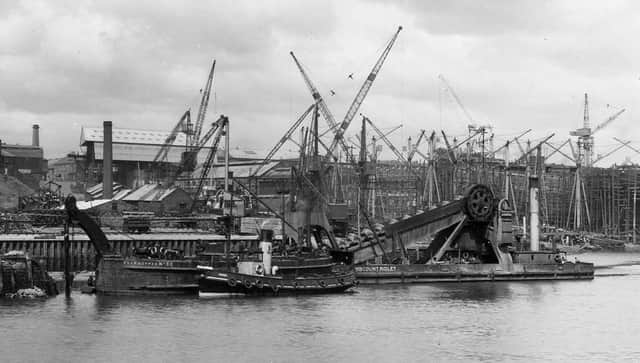ON THE WATERFRONT: Dredger became a regular sight on the Wear and docks


Launched on September 8, 1909 by Fleming and Ferguson Ltd on the Clyde, Viscount Ridley was classed as a non self-propelled pontoon dredger with a registered length of 13 feet and 30.1 feet beam.
Fitted with a centre bucket ladder, the 336 gross ton vessel was ordered by Blyth Harbour Commission (BHC), which was then carrying out major harbour improvement and deepening work, including removal of about a million tons of rock.
Advertisement
Hide AdAdvertisement
Hide AdTwo barge-mounted Lobnitz rock-breakers had been acquired to pulverise bedrock by repeatedly dropping long, heavy chisel-ended rams.
Using her buckets, Viscount Ridley would then dredge the broken rock at a rate of 200 tons per hour at a maximum low water depth of 45 feet.
Owing to the progress made in deepening their harbour, BHC was able to temporarily dispose of rock-breaking and dredging equipment, allowing Viscount Ridley to be chartered to Workington Harbour and Dock Board in 1928.
She was sold to KL Kalis Sons and Co Ltd of London in 1931, and then contracted to the River Wear Commissioners (RWC) in connection with the deep water Corporation Quay construction scheme.
Advertisement
Hide AdAdvertisement
Hide AdIn 1934, as the project drew to a close, the RWC purchased the dredger from Kalis for £4,000 plus £480 for spare parts. After reconditioning, repairs and reclassification she was put to work at Sunderland but hired back to Kalis in 1936 for dredging at Granton near Edinburgh.
On her return to the Wear, Viscount Ridley became a regular sight in the river and docks, some of her most notable work including widening Hendon Dock junction, river widening above Wearmouth Bridge, removal of Folly End and formation of a new entrance into North Dock.
In June, 1967, while alongside port workshops in the Half-Tide Basin, she capsized and sank, badly damaging her dredging gear. She was eventually righted by two West German salvage vessels - Magnus IV and V.
Unfortunately, this mishap spelled the end for the old craft, which was sold to Shepherd and Sons Ltd for scrapping in the RWC graving dock in 1968.